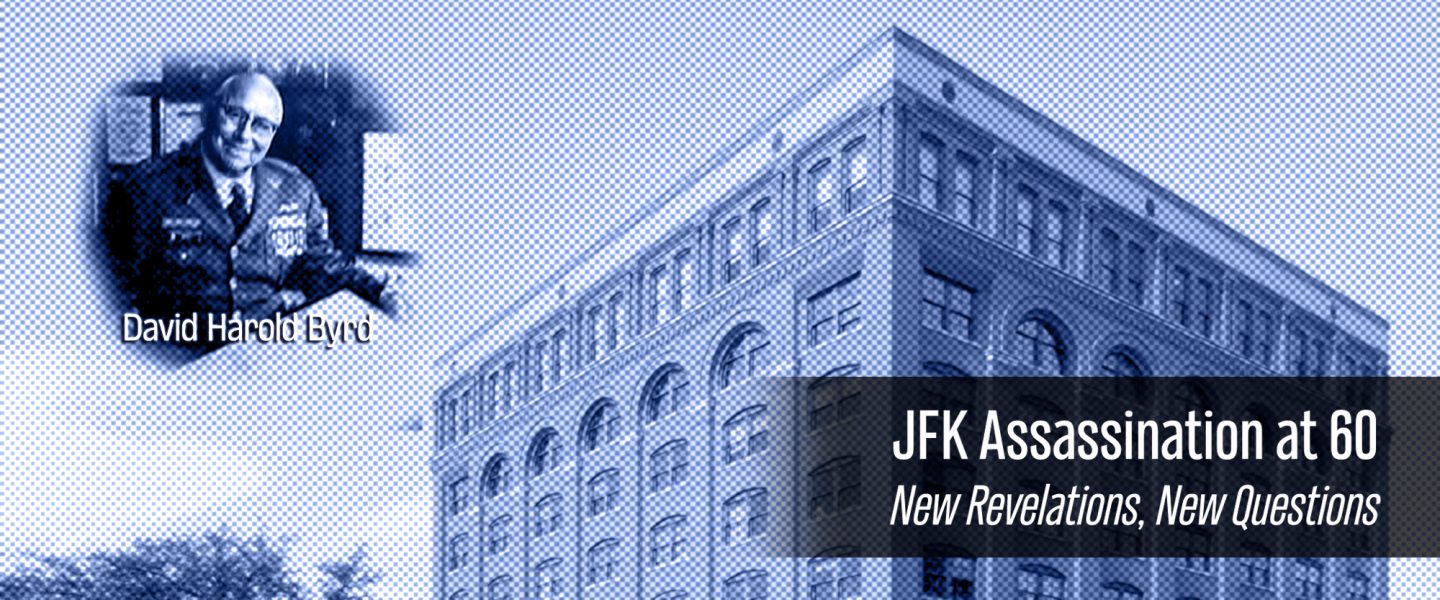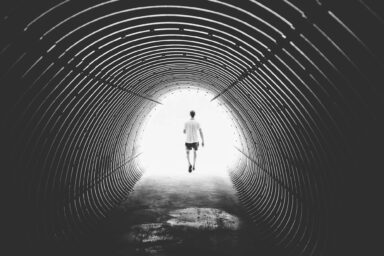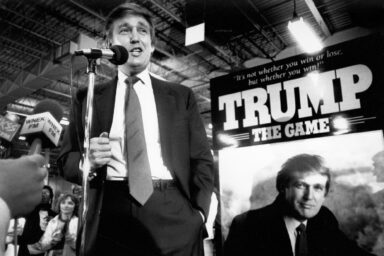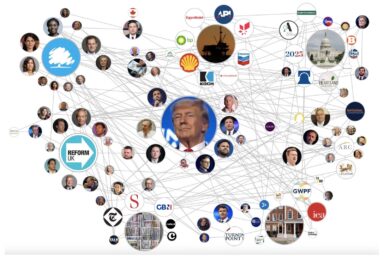The strange story of a powerful man who owned the notorious building from which Oswald supposedly killed Kennedy. Was he really hunting in Africa, while others hunted the President?
|
Listen To This Story
|
I’d like to introduce you to one of the most fascinating figures you’ve not heard of, a man whose secretive activities should have gotten the close scrutiny of officials investigating who killed John F. Kennedy — had there been a serious investigation.
This man owned the building from which, we are told, Lee Oswald fired the shots that killed Kennedy. He was rich and powerful and well known in his time. He’s all but forgotten today. I came upon him while working on my previous book, Family of Secrets, and trying to understand how it was that Oswald fortuitously obtained a job in a building that turned out to be at a critical spot in a motorcade route supposedly determined later.
Oswald’s presence in that building at that time has always been characterized officially as a stroke of luck for him and bad luck for the country. We’ve always been told that Oswald couldn’t have known the details of a not-yet-announced Kennedy visit, and certainly not a specific route for a possible motorcade, past a particular building, when he applied for his job.
So he just happened to be there, and then, we are told, decided spontaneously to bring a rifle and kill Kennedy, a highly suspicious concatenation of coincidences.
And what does all this have to do with the man who owned the notorious Texas School Book Depository Building?
We’ve discovered some things that mean this man will need a close reexamination. Most startling is that he wasn’t where he said he was for most of November 1963. And that raises serious questions about why he would engage in a deception — a pretty elaborate one too, as you’ll see — about where he was for the period of the assassination, which was seemingly committed from his building.
Meet Harold Byrd — LBJ’s Boss?
The man I am talking about is David Harold Byrd, who commonly went by D.H. or Harold Byrd. He’s fascinated me for years. Born at the turn of the 20th century, he struck it rich in oil, then expanded over the years until he became a true cross-industry tycoon, with major holdings in everything from uranium mining to military contracting.
He acquired a high-powered set of friends, in particular Lyndon Johnson, one of John F. Kennedy’s opponents for the 1960 Democratic nomination — a man who made it known he hated the Kennedys, was jealous of them, and couldn’t wait to be president himself, though he also knew he was unlikely to win the office outright at the ballot box.
Johnson told a friend he was well aware that numerous presidents had died in office and, being a betting man, he’d take his chance in accepting the vice-presidential slot under Kennedy.
Byrd and Johnson were really close. So close that Byrd was not above trying to boss Johnson around — and that is no small claim. Once, piloting his private plane, Byrd radioed Johnson at his ranch and announced he was going to land. President Johnson must have been busy, because he told Byrd not to. Byrd went ahead and landed anyway.
Keep that in mind when you consider the amazing stroke of luck that Oswald got a job in Byrd’s Dallas building before any ordinary citizen could have known that a presidential motorcade would pass by. And then consider that some people did know — the very people who were working on and pushing for the motorcade to happen, including Texan Lyndon Johnson — a man whose political career was teetering on the brink, and whose own people were instrumental in managing Kennedy’s trip to Dallas from day one.
There also seems to have been an intent to obscure the importance of Byrd’s building. Even at this late date, 60 years after the fact, it’s unclear exactly who made the fateful decision to divert the motorcade from its initially planned route straight down Main Street onto, instead, a sharp dogleg turn that would take it past the Book Depository at low speed.
Conflicting accounts given by Secret Service agents and Dallas police officers over the years have only further muddied the waters. And Johnson and his associates, including Texas Gov. John Connally, repeatedly insisted — despite much evidence to the contrary — that it was JFK and the White House pushing for the Texas trip all along. Evidence shows Connally was adamant that Kennedy speak at a particular venue — a venue that necessitated the motorcade traveling through downtown Dallas and near the Book Depository.
A Lineup of Linchpins
OK, but what about Byrd? To understand his significance to the tragedy that played out on November 22, 1963, you need to know something about his circle of powerful friends and colleagues. Byrd was close buddies with a whole raft of people at the pinnacle of the national security state, including generals. His own politics were way to the right of his good friend Johnson’s — he even traveled to Nazi Germany several years before World War II and had a brief meeting with Hitler. When Byrd returned to the US after that encounter, he spoke positively of Hitler’s “sincerity” and “basically sound policies.”
Among his vast web of business holdings, Byrd owned a building in downtown Dallas on a corner of Dealey Plaza, an intersection just before one enters a freeway. As an investment, the building had become a bit of a lemon, largely empty in the early 1960s. Within a year before Kennedy’s visit, though, a new tenant moved in, a firm called the Texas School Book Depository (TSBD), which distributed books from national publishers to schools throughout the Southwest.
The owner of the TSBD, Jack Cason, leaned far right himself, and had his own military connections. He even headed up a Dallas post of the military adjunct American Legion, which was also closely tied to J. Edgar Hoover, the FBI, and the Cold War national obsession with investigating “subversives.”
At some point in the year before the motorcade (the exact date has proven oddly difficult to nail down — even the Sixth Floor Museum, dedicated to the assassination and located in the building, told me they didn’t know), Cason relocated his operation from nearby to Byrd’s building, and became the primary tenant, so the building was renamed after Cason’s firm.
In October 1963, Lee Oswald applied for a job with Cason’s firm, and even though it was off-season for schoolbook purchases and the firm had laid off non-essential personnel, for some reason it found this unprepossessing applicant with a reputation as a left-wing dissident especially appealing and put him to work (according to an oral history interview with Cason’s widow), ostensibly laying flooring and filling the odd book order.
As for the TSBD company itself, several former employees have described to me and others company activities, including the apparent covert shipment of things other than books in book cartons, that made clear to them the outfit had its own connections with the intelligence world. In addition, Elzie Glaze, a reporter for the Austin American-Statesman, researched and interviewed Bill Shelley, Oswald’s supervisor, and later noted, “Mr. Shelley claims to have been an intelligence officer during World War II and thereafter joined the CIA.”
Cason and his company clearly deserve more scrutiny, but my focus here is on the more powerful Harold Byrd.
Where Was Byrd That Day, Really?
Any serious investigation into JFK’s assassination would have probed Oswald’s path to being in the building that day. That was a central mystery of the assassination. But the Dallas police, the FBI, and the Warren Commission, while going through the motions of scrutinizing how Oswald landed the job when he did, concluded it was all just an uncanny coincidence — that a guy with an inclination to assassinate (how many of those are there?) unwittingly got the perfect opportunity to do so. Which meant they failed to examine Byrd’s ownership of the building, which meant they failed to interview him and ask him whether he knew Oswald, whether he knew how Oswald had been hired, etc. And of course, they never asked Byrd where he was when he learned that his own building had harbored Kennedy’s killer.
To this day, as I’ve said, Byrd has eluded scrutiny.
But given the cataclysmic import of the events of November 22, 1963, it’s surely not too late to open that inquiry. Question No.1: Where was Byrd that day? Answer: We don’t really know. But I’ve unearthed some strong hints about where he wasn’t.
Working with a ghost writer, Byrd later published a vanity autobiography, and although he makes some effort to enliven his life story with anecdotes that might interest general readers, nowhere does he mention November 22, his ownership of the TSBD building, or his presumed consternation on learning the building’s role in the crime of the century. In fact, about the JFK assassination he says precisely… nothing.
To me, that’s passing strange.
Looking deeper into his whereabouts on and around that tragic day, here’s one thing I found: There is no evidence that he was in Dallas. We wouldn’t expect there to be, because he soon put the word out that he’d been away. But, on the other hand, what I also found that definitely roused my curiosity was an apparent effort by Byrd and associates to plant stories about him that pointed to his being thousands of miles away from Dallas at that time — on a hunting safari in Mozambique, a place he had never been to before. Why do that?
And what was more curious still, the closer I looked into the tale of the safari, the more it seemed that Byrd, with a little help from his friends, had made up that whole story. For reasons that a JFK assassination investigator can only speculate about.
I’ll take you through the details of what I found, and you can decide for yourself if there’s a plausible benign explanation.
But before we get into sniffing around the safari story, it’s worth noting that, in addition to being close to the man who became president when Kennedy was killed, and hosting the man who ostensibly killed Kennedy, Harold Byrd had a third distinction: He knew a CIA-connected intelligence operative named George de Mohrenschildt who had been asked by the CIA to “keep an eye” on Oswald a year before the assassination.
Even the briefest summary of the connections between de Mohrenschildt, Byrd, and Oswald at this time risks sounding like a page from an overheated spy thriller.
In October 1962, shortly after Oswald abruptly moved to Dallas from Fort Worth, de Mohrenschildt, who had worked for Byrd years earlier, began helping Oswald and his wife get settled in their new home. At around the same time, de Mohrenschildt set up a charity board and put Byrd’s wife on it.
Note that Byrd was co-founder and, for decades, a top leader of the Civil Air Patrol (CAP), an Air Force auxiliary. I’ve found evidence that it was also used for covert operations, including a plan to send selected CAP recruits to the Army Counterintelligence School in Maryland to “be taught the Russian language, Russian military tactics, Russian politics and all characteristics of the Russian people.” Sounds a lot like defector training, doesn’t it?
While Byrd was commander of the Texas and Louisiana region of the Civil Air Patrol (1948-53), an eccentric pilot named David Ferrie joined one of its Louisiana chapters, eventually becoming a squadron leader. It’s now known that Ferrie got deeply involved in a range of right-wing activity, including gun-running and working with anti-Castro Cubans.
In 1955, Ferrie crossed paths at the Louisiana CAP with Lee Oswald, then a teenage New Orleans air cadet. As we know, some years later this same Oswald, having somehow taught himself Russian, and with a defection to the Soviet Union under his belt, ended up working in a Dallas building owned by Byrd.
With that as context-setting background, let’s return to the question of why Byrd might have gone to so much trouble to create the impression that he was in Africa hunting elephants on November 22, 1963. Well, for one thing, his ownership of the TSBD building might have shined an uncomfortable spotlight on his activities around the time of the assassination.
Having owned this building for decades, and being hands-on, he knew the innards of the structure better than anyone else. This is important when you consider how all aspects of the building have been examined and reexamined over the years in an effort to nail down what actually happened when the president of the United States was gunned down in broad daylight on the street in front of the TSBD.
Because Oswald, the sole suspect, was killed in police custody two days after the assassination — and so never had a chance to tell, in detail, exactly what he knew — the investigation into the murder revolved around physical evidence at the crime scene, with prime focus on Byrd’s building.
To reconstruct what happened, investigators had to consider such details as: the location of the passenger and freight elevators, and which elevator went up to which floors; the layout of the stairwells and other potential hiding places; the distances and times it would take for a shooter (or shooters) to fire their weapon(s), hide their guns, and descend, undetected, a number of floors so as to be seen standing, as Oswald was, on the second floor, calmly holding a soda, when spotted by other employees and a police officer in the building just moments after Kennedy was hit.
If I were running a clandestine operation out of that building, I’d want Harold Byrd by my side offering intimate building details as I was dealing with the police radio, the movements of various law enforcement agencies into the building, and so on.
I would certainly not want him far away, unreachable, in some steamy African savannah. (Indeed, Byrd’s purported trip came in the last weeks of the local hunting season, when the heat typically became oppressive; even the safari camp advertised that it closed as of December 1).
But I also wouldn’t want him visible in Dallas, doing anything publicly.
On the other hand, if I were Byrd and I were involved in something of this nature, the first thing I’d worry about is covering my own ass. In short, I’d need a good story, should anyone ask questions.
Back in the days where there were no cell phones or other modern means of tracking someone away from “civilization,” what better story than being away on an African safari — especially for someone already known to be an avid hunter.
‘Shot By Harold Byrd Dec. 7 1963’
It’s not as if there aren’t some pieces of evidence that Byrd was on safari in Africa for several weeks in late 1963. But on closer examination, this evidence is revealed to be… highly dubious.
Consider photos posted to an online gallery by Christian von Alvensleben, a nephew of the owner of the safari camp, who worked there as a photographer. One shows a man that the photographer was told was “Byrd.” Von Alvensleben remembers him and a companion arriving in early November 1963 and staying over a month. (We cannot reproduce these safari photos on this page for copyright reasons. Sorry about that. But the links take you directly to the photos in question.)
Take a close look at “Byrd,” the man with a mustache smoking a cigar, and compare it with the ones below whom we consider the real Byrd. Notice especially the eyes.
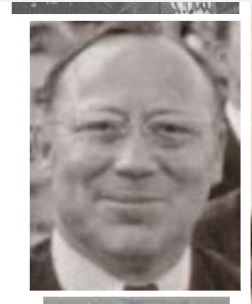
His eyes recede beneath puffy upper lids. His face appears fairly flat because the brow ridge, forehead, and eyes all seem to be almost on the same plane. His brows are narrow and wispy.
The eyes of our presumed imposter are very different. The brow ridge protrudes more, and his brows are bushy and sharply arched. His ears also seem different. And he doesn’t seem to have the real Byrd’s somewhat pointed chin. He’s also less rotund than Byrd was at this stage. By almost any measure, this is simply not the same person.
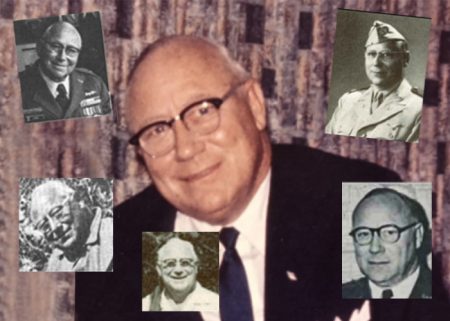
I sent the photo of the mustachioed man to several people who knew Byrd. None of them thought it was he.
Also: The real Byrd was a proud hunter who, like most hunters, routinely posed for pictures next to his trophies. Yet in the online photo gallery we see a picture of a dead elephant lying on its side, with two Mozambican guides holding its ear aloft.
On the ear is painted “Shot by Harold Byrd. Dec. 7 1963.”
And no Harold Byrd standing beside it.
What kind of hunter does that? Arguably, only one who’s keen to keep his face out of the picture while creating the impression that he, or rather the person being impersonated, was there.
In fact, the purported Byrd was so keen to leave a false trail that, von Alvensleben tells us, throughout his visit the presumably false Byrd had a brush and a can of paint stowed in the Land Rover during his hunting sorties — apparently waiting for a chance to paint Byrd’s name on something big enough.
It’s hard to avoid the conclusion that the guy who presented himself as Byrd, arriving at the hunting camp two or three weeks before the assassination, was an impostor. And who could have sent him except Byrd, or people acting on his behalf, to substantiate a story that Byrd was nowhere near Dallas in late November?
The more safari photos you look at, the more doubts arise. The purported Byrd showed up with a companion, an American with a Southern accent who called himself Thomas May.
However, a Dallas Morning News article on January 19, 1964, which mentioned Byrd’s hunting trip, said that his companion was Dr. Vanda Davidson, a leading Dallas gynecologist. But von Alvensleben, the photographer, reports no Davidson with Byrd. Period photos of Davidson show that he is not the same man as the “Thomas May” who appears in von Alvensleben’s photos.
Von Alvensleben (full Mozambique gallery here) recalls that May described himself as a former Marine colonel, now a schoolbook writer or editor. Extensive searches have found no historical record of someone with that name fitting that description. So it looks like both hunters were using false names.
For what it’s worth, the weather in that part of Mozambique in November tends to be searing hot. A 1990s aid project in the same district once recorded 117°F at that time of year. This hunting camp received very few visitors that late in the season. Although these two mystery men managed to hunt despite the heat, it’s hardly the time of year a rich hunter would choose to go there.
Whoever the two men on safari were, they weren’t too dismayed when news of the JFK assassination reached the camp by shortwave radio broadcast: “Thomas May” bought everyone a round of drinks. And “Byrd” made no move to rush back to the US to assist the authorities in their investigation, which centered on his building.
The implications of someone in Byrd’s position going to such lengths to create a false alibi, covering the period his building was used for an assassination, are, frankly, chilling.
It’s always possible, of course, that one or another of these head-scratching anomalies has some innocent or alternate explanation. Maybe Byrd was actually away on a secret love tryst. Still, the links between Byrd and the JFK assassination are so extensive, and so prima facie questionable, that it’s hard to believe the redoubtable Mr. Byrd wasn’t more thoroughly investigated at the time.
I’m thinking, of course, about his strategically located building, his financial and personal ties to major figures in the military complex, his connections to key figures in the JFK assassination saga, and, above all, his close ties to Johnson, which together could have made him indispensable to a possible assassination plot.
What could he have been doing that would explain such an elaborate stunt of sending an impostor to Africa to paint his name on elephants?
We’ll be delighted if anyone comes forward with solid new information about Byrd’s whereabouts in November 1963, or who recognizes the false Byrd or Thomas May. (Please see contact links below.)
The real Byrd, by the way, made millions on his military contracting investments after his friend Johnson ascended to the presidency and quickly escalated US involvement in Vietnam.
Oh, yes, another curious detail: Sometime after 1963, Byrd had the sixth-floor window from which Oswald supposedly fired his kill-shots at Kennedy removed from his Book Depository building — and installed in his banquet room.
It remained there, hung like a trophy, for more than two decades.
***
I thank Robert Smith for his insights and other substantial contributions to this article.
_______________________________________________________________
About the JFK Assassination Series
This series was inspired by an ongoing project of WhoWhatWhy Founder and Editor-in-Chief Russ Baker to produce a definitive, meticulous, book-length investigation of Kennedy’s death.
Robert Smith, coordinator of this JFK series, is part of the research team helping Russ Baker with his upcoming book. He is a retired United Nations humanitarian-relief official living in Europe.
Click here for the introduction to the series. To see all the articles in the series, click here.
If you have information to bring to our attention about any aspect of the JFK assassination — or are with the media and interested in covering or reproducing our work or inviting Mr. Baker to appear on a program — please click here.
If you would like to be on a mailing list to receive news of the book, click here.
To sign up for WhoWhatWhy newsletters, click here.
